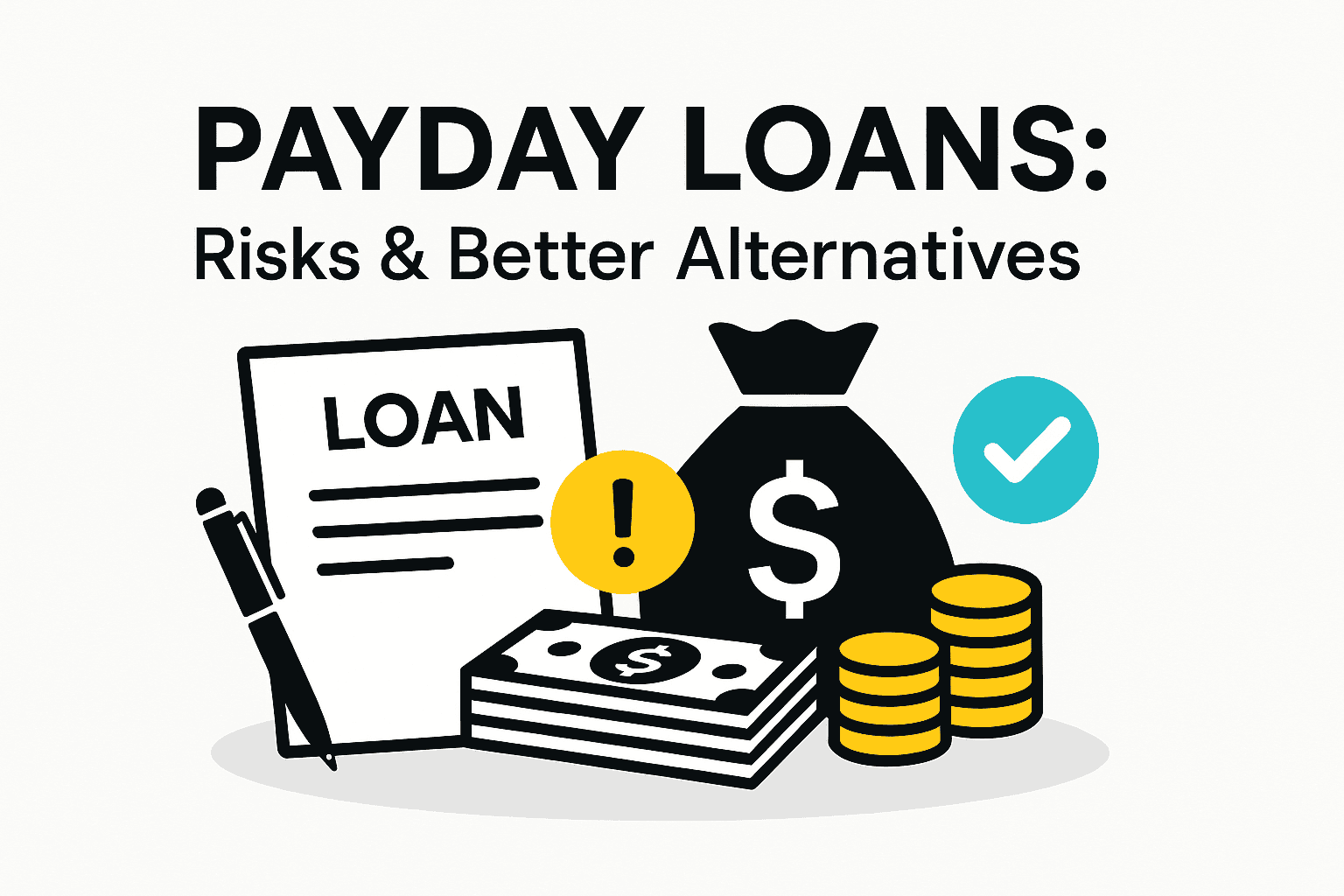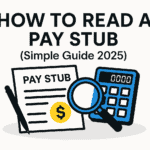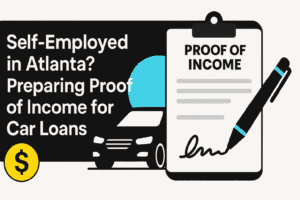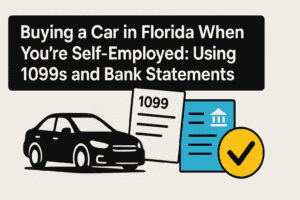Last updated: August 2025
Payday loans are short‑term, high‑cost credit that promise fast cash but often create long‑term problems. These loans usually offer $500 or less, due in full by your next payday, and the fees can push the APR to extreme levels. This guide explains how payday loans work, shows the math behind APR and rollovers, and highlights practical Payday loan alternatives available in the United States, the United Kingdom and Canada.
At FinancialDocsProvider.com, we specialise in editing, formatting and organising proof‑of‑income documents so lenders and landlords can verify your information quickly. We do not fabricate numbers or change dates; we present genuine records clearly and securely. This article is educational and not financial advice—always consult qualified advisers before borrowing.
Related Entities & Terms
- Payday loans, cash advances, small‑dollar loans
- Credit‑builder loans, credit union small‑dollar loans
- Salary advance programs, employer‑sponsored loans
- Community support programs, non‑profit lending, religious charities
- W‑2, 1099, T4, SA302 and Notice of Assessment (NOA) forms
- Regulators: Consumer Financial Protection Bureau (CFPB), Federal Trade Commission (FTC), Internal Revenue Service (IRS)
- Financial Conduct Authority (FCA, UK), GOV.UK guidance and Fraud Act 2006
- Financial Consumer Agency of Canada (FCAC), Canada Revenue Agency (CRA) and provincial consumer affairs offices
- Annual Percentage Rate (APR), Military Annual Percentage Rate (MAPR)
- Debt‑to‑Income (DTI) ratio, affordability checks, payday loan caps
How do payday loans work and what are the legal basics?
Payday loans are typically small advances due on your next payday and they carry very high fees. Regulations differ by country and state or province, but they generally aim to increase transparency, cap costs and limit harmful rollovers. In this section, you’ll see how payday loans are structured, how fees translate into APR, and why the rules exist.

What is a payday loan?
A payday loan is a short‑term, high‑cost loan, generally for $500 or less in the United States. You provide proof of income—such as a pay stub or bank statement—and either write a post‑dated check or authorise an automatic withdrawal for the amount borrowed plus fees. The lender holds this instrument until your next payday, usually two to four weeks later.
Because most payday lenders perform limited credit checks, approval is fast and marketing focuses on emergencies. The convenience can hide the true cost. For example, borrowing $375 for 14 days at $15 per $100 means a fee of $56.25 due alongside the principal. If cash is tight, repaying the full balance and fee in one lump sum can be difficult—often triggering rollovers and more fees.
How is APR calculated on a payday loan?
Payday lenders usually charge a flat fee for every $100 borrowed. In many U.S. states that permit payday lending, fees range from $10 to $30 per $100. A typical two‑week loan with a $15 fee per $100 equates to an APR near 400 %—far higher than most credit cards.
The calculation is straightforward. Divide the finance charge by the loan amount, multiply by the number of periods in a year (26 for 14‑day loans) and multiply by 100 to express a percentage. Using $100 with a $15 fee, APR ≈ (15 ÷ 100) × 26 × 100 = 390 %. If the term is shorter than 14 days or the fee is higher, the APR climbs even more.
What happens when you renew or roll over a payday loan?
Some lenders let you renew or “roll over” if you can’t repay on time. Rolling over means you pay a fee to extend the due date while the principal remains. According to the Consumer Financial Protection Bureau, if you borrow $300 and owe $345 after 14 days, paying only the $45 fee means you will still owe $345 two weeks later.
Each rollover adds fees without reducing the debt. Three consecutive rollovers on a $300 loan at $45 per period would cost $135 in fees while the $300 principal remains. That is why many jurisdictions either limit rollovers or require extended payment plans to help you exit the cycle.
How are payday loans regulated in the United States?
The United States permits payday lending in many states, but regulators cap fees and loan amounts. A common fee is $15 per $100 borrowed, which yields an APR close to 400 %. Servicemembers have stronger protections under the Military Lending Act, which caps the Military Annual Percentage Rate (MAPR) at 36 %.
States may also limit rollovers, require extended payment plans and mandate clear disclosures. In states that prohibit payday lending, borrowers typically turn to credit unions, banks or community programs for small‑dollar loans. Always check the rules in your state before signing an agreement and compare alternatives with lower, transparent costs.
What about payday loans in the United Kingdom?
In the UK, high‑cost short‑term credit is tightly regulated. The Financial Conduct Authority (FCA) caps initial costs at 0.8 % per day, limits default fees to £15 and sets an overall cost cap of 100 % of the amount borrowed. That means if you borrow £100 for 30 days and repay on time, total fees and interest cannot exceed £24.
Lenders must run affordability checks and cannot roll over a loan more than twice. You should verify that any lender you consider is FCA‑authorised and uses fair collection practices. If you are struggling, contact the lender early to discuss payment plans rather than extending the loan.
How are payday loans regulated in Canada?
In Canada, payday lending rules operate at both federal and provincial levels. Provinces that regulate payday loans cap the cost at CA$14 per CA$100 borrowed, which implies an annual rate around 365 %. Lenders may also charge a one‑time fee of CA$20 for a dishonoured cheque.
Most provinces prohibit rollovers, so lenders cannot extend due dates for an added fee. If you miss a payment, you may owe interest, fees and collection charges, so review the agreement carefully before signing. If costs look high, consider lower‑cost community programs or credit unions.
Across jurisdictions, the takeaway is clear: payday loans are expensive. Compare safer options and prepare your documents carefully so legitimate lenders can verify your information and offer better terms.
Which document edits are allowed for loan applications?
Good formatting speeds up reviews and protects your privacy. The key is to enhance clarity without altering facts. Below are common, permissible edits that help you present accurate information to lenders—whether you seek a credit‑builder loan, an employer advance or other Payday loan alternatives.
Redaction for privacy
You may remove or obscure sensitive details such as account numbers, Social Security or Social Insurance numbers and home addresses, provided transaction information remains intact. For example, you can mask all but the last four digits of your bank account number or hide your personal address on a pay stub. Use proper PDF redaction tools that permanently remove the text layer rather than drawing black boxes over visible data.
Practical tip: after redacting, re‑open the file and try to search for the hidden text. If search still reveals the original data, your tool did not truly redact. Export a flattened PDF to prevent accidental exposure when a file is forwarded or re‑scanned.
Legibility and accessibility fixes
Lenders often reject blurry scans or photos taken at an angle. You can improve legibility by rescanning at 300 DPI or higher, rotating pages upright, adding optical character recognition (OCR) to scanned PDFs and adjusting contrast. Combining multiple pages into a single, bookmarked PDF helps reviewers navigate quickly.
These edits do not change numbers or dates; they simply make existing information readable. If a portal rejects image‑only PDFs, ensure OCR is enabled so underwriters can search for amounts, dates and employer names.
Format conversion and export
Converting a payroll report to PDF or exporting official bank statements from online banking are permissible edits. When converting, avoid cropping pages or layering screenshots that might look like tampering. Download complete statements with page numbers and the bank’s footer data when possible.
Our team can advise on packaging diverse file types—pay stubs, bank statements, tax forms and proof of address—into a clean, lender‑ready packet. Clear organisation reduces back‑and‑forth and helps you avoid delays.
What document edits are illegal and why?
Changing facts on a financial document to obtain credit is fraud. The consequences can include account closure, civil liability and criminal charges. This section explains common illegal edits so you can avoid mistakes and keep your application compliant.
Changing amounts, dates or payees
It is illegal to modify income figures, hourly rates, hours worked, tax withholdings or any other monetary amounts on a pay stub or bank statement. Backdating pay stubs, changing pay periods or inventing employers is also fraud. If your records contain an error, ask the issuer for a corrected version rather than editing it yourself.
Even “small fixes” can trigger big problems. Lenders cross‑check year‑to‑date totals, deposit patterns and employer tax IDs. A single inconsistent digit can cause underwriters to halt the review and label the file as high risk.
Fabricating or removing transactions
Adding fictitious deposits or hiding overdrafts is never permissible. Lenders compare bank activity against payroll deposits, tax forms and credit reports, and discrepancies raise immediate red flags. Removing transactions—such as gambling, cash advances or large cash withdrawals—to make your account appear healthier may lead to fraud investigations.
If you have unusual transactions, disclose them proactively and explain the context. A brief cover note is far safer than editing statements and hoping the reviewer does not notice.
Altering identities and supporting documents
Editing names, addresses or identification numbers to impersonate another person or misrepresent your residency or employment is illegal. Using someone else’s payslip, forging employer letters or altering logos and signatures can lead to forgery charges. In the UK, the Fraud Act 2006 prohibits “making a false representation” with intent to gain financially, and similar offences exist in the US and Canada.
Remember: formatting, redacting and organising documents is allowed; changing facts is not. When in doubt, speak to your lender, a regulator or a qualified attorney before submitting edited materials.
When do you need professional document formatting?
Clean, consistent documentation can unlock safer credit options and reduce stress. Lenders, credit unions and community programs base eligibility on your income history and account behaviour. Below are common situations where professional formatting helps you avoid high‑cost payday loans.
Applying for credit‑builder loans
Credit‑builder loans are small instalment loans from credit unions or community banks. Instead of handing you the funds up front, the lender places the proceeds in a secure account while you make payments for 6–24 months. On completion, you receive the money and a positive payment history.
To qualify, you usually provide recent pay stubs, bank statements and tax documents. Professional formatting shows steady deposits, clarifies variable hours and highlights employer consistency. If you have multiple jobs, include a simple cover sheet that maps each deposit to the corresponding pay stub for quick reconciliation.
Mini‑scenario: Taylor works two part‑time jobs and receives tips. We combine pay stubs, add a short note explaining tip frequency and annotate bank statements with bookmarks. The lender can reconcile deposits in minutes, improving the odds of approval.
Using salary advance or earned wage access
Many employers offer salary advances or partner with earned wage access providers that let you draw a portion of earned wages before payday. Fees are typically low and avoid high APRs. Applications often request proof of employment and recent pay history.
Submit crisp pay stubs, remove unnecessary personal identifiers and ensure dates align with your payroll calendar. If your employer changes pay cycles, include a one‑page note showing the transition so the reviewer understands the timing.
Exploring community and non‑profit lending
Non‑profits, faith‑based organisations and community development financial institutions (CDFIs) may offer small‑dollar loans, emergency grants or zero‑interest funds. Many also provide budgeting help or credit coaching. These programs usually require proof of need and evidence of income.
Organised documentation can shorten processing time. Provide your most recent statements, show consistent income sources and include a brief summary of your monthly obligations. Clarity helps administrators confirm eligibility without repeated follow‑ups.
Other safer alternatives
- Installment loans from banks or credit unions. Interest rates are generally lower than payday loans, and payments are spread over several months.
- Overdraft lines of credit. Authorised overdrafts can be cheaper than payday advances when used sparingly.
- Payment plans with service providers. For utilities or medical bills, ask for instalments or hardship programs rather than borrowing at high rates.
- Borrowing from family or friends. If you do this, document the agreement and set a payment schedule to protect relationships.
- Short‑term income boosts. Side gigs, overtime or small freelancing tasks can cover a gap without creating new debt.
Whatever path you choose, understand the terms and prepare your paperwork. Clear records help lenders confirm your ability to repay and may lead to better pricing.
How does FinancialDocsProvider.com work?
Submitting neat, well‑organised documents can help you qualify for safer credit options. Our process is designed to improve clarity, reduce back‑and‑forth and keep your data secure. Here is what to expect.
Intake and consultation
We start with a brief consultation to understand your goals—credit‑builder loan, salary advance or another option. You upload your existing documents via our secure portal. We review for completeness, legibility and potential issues that might slow an application. We never ask for banking or payroll logins; you remain in control.
Reconciliation and verification
We reconcile documents for consistency. Bank deposits should match net pay on your pay stubs, and YTD totals should line up across the set. If we find discrepancies, we flag them so you can investigate or request corrected statements. We do not alter numbers, dates or payees.
When you have freelance or mixed income, we add a brief mapping sheet that lists each client or job, associated deposits and invoice dates. This helps underwriters follow the money trail with minimal effort.
Formatting and organisation
Once your data checks out, we enhance readability and structure. We combine pages into a single PDF, add bookmarks, correct rotation and contrast, convert images to searchable text via OCR and redact sensitive identifiers. If your file spans multiple income sources, we include clear section dividers so reviewers can evaluate each stream quickly.
Delivery and support
We deliver a secure download containing two folders: the final packet and a retention set of your originals. If your lender requests extra documents or a different order, we help you re‑package the set. We focus solely on document preparation; we do not complete applications or negotiate with lenders.
For more details about our process, please see our About page. If you have questions about pricing or timelines, see our services and pricing information or contact our team.
What’s on the compliance checklist?
A concise checklist helps you submit the right documents on the first try. Use these steps to assemble a compliant packet for credit‑builder loans, employer advances and other Payday loan alternatives. Following them reduces rejections and keeps reviews on schedule.
- Gather recent proof of income. Collect at least two to three of your most recent pay stubs or payslips. Self‑employed borrowers should gather invoices, profit‑and‑loss statements and tax documents like 1099s, T4s or SA302s.
- Download official bank statements. Obtain PDF statements directly from your bank’s website rather than screenshots. For side gigs, include separate statements for business accounts.
- Check consistency. Compare deposits on your bank statement to net pay on your pay stubs. Year‑to‑date (YTD) totals should align with cumulative deposits.
- Redact sensitive data. Mask account numbers and personal identifiers while leaving transaction details visible. Use a proper redaction tool rather than a digital highlighter.
- Scan for legibility. Ensure each page is clear, upright and easy to read. Add an OCR layer to scanned documents so underwriters can search the text.
- Organise your files. Merge documents into a single PDF with a logical order: cover sheet, pay stubs or income statements, bank statements and any supplementary documents (e.g., employment verification letters). Include bookmarks or a table of contents for quick navigation.
- Add context. If your income varies or you receive irregular deposits (e.g., tips or freelance payments), include a brief note explaining the nature of these transactions. This helps lenders understand your cash flow.
- Review legal boundaries. Never change amounts, dates, payees or transaction descriptions. If something looks wrong, get an official correction rather than editing the document yourself.
- Match identities across documents. Confirm that your name, address and tax identifiers are consistent. Update outdated addresses with your bank and employer before applying.
- Use clear file names. Name files with the date and document type (e.g., 2025‑07 Paystub Employer‑A.pdf) so reviewers can find items quickly.
- Include contact details. If a lender verifies employment, provide the correct HR or payroll contact to avoid delays.
- Keep a copy of everything. Save the exact packet you submit. If questions arise, you can reference the same version the lender is reviewing.
Once you complete these steps, you’re ready to submit. Respond promptly to any lender requests and remain transparent about your situation.
What red flags trigger loan application rejections?
Underwriters are trained to spot inconsistencies and signs of tampering. Knowing the common triggers helps you avoid avoidable errors. Here are frequent problems that cause delays or denials—and how to prevent them.
Math mismatches and inconsistent totals
If YTD earnings on a pay stub don’t match the sum of prior stubs, reviewers will question accuracy. Similarly, bank deposits that diverge from net pay can suggest undisclosed income or missing pages. Double‑check totals before sending your packet.
Formatting errors that mimic fraud
Mismatched fonts, uneven spacing or misaligned columns across pages can look like edits, even when innocent. Avoid mixing screenshots from different statements or cropped images that remove headers and footers. Keep page sizes, margins and footers consistent to maintain trust.
Over‑redaction or missing pages
Protect privacy without creating gaps. Redact only what’s necessary, and never remove entire pages. Watch for missing page numbers or sudden jumps in statement sequences, which suggest omitted information.
Discrepancies in personal identifiers
Names, addresses and tax or national insurance numbers should match across all documents. A misspelled surname or an outdated address can delay verification or trigger enhanced screening. Update records before you apply to avoid confusion.
By steering clear of these pitfalls, you present a credible, easy‑to‑review file. For more detail on common errors, see our article on loan application red flags.
Official resources & helpful links
When researching payday loans and safer options, rely on authoritative sources. The links below explain how these products work, outline costs and describe your rights as a borrower. Use them to verify rules in your location and to plan a safer path.
Official regulators and guidance
- CFPB: What is a payday loan? – Explains payday loan features, fee caps and borrower rights in the United States.
- CFPB: Rolling over a payday loan – Provides examples of rollover fees and guidance on avoiding debt traps.
- FCA: Payday lending price cap – Details the UK cost caps (0.8 % per day, £15 default fee cap and 100 % total cost cap).
- FCAC: Payday loans – Outlines the cost of payday loans in Canada, provincial regulations and borrower rights.
Related articles on FinancialDocsProvider.com
- Car loans and auto finance: How many pay stubs do you need? – Proof‑of‑income requirements for auto financing and how to package your documents.
- How to qualify for a title loan with bad credit or no credit – High‑cost secured loans, APR calculations and compliance tips.
- Common legal mistakes in bank statement editing – Allowed vs. illegal edits and red flags when preparing bank statements.
- For help with proof of income editing, bank statement formatting, or to understand our pricing, explore our services page.
FAQs
Here are concise answers to common questions about payday loans, APR math, safer options and document preparation. They are intended for education only and are not financial or legal advice. Always consider your own situation and seek qualified guidance.
How is the APR on a payday loan calculated?
The annual percentage rate (APR) converts short‑term fees into a yearly rate so you can compare costs across products. For a two‑week payday loan, divide the finance charge by the loan amount, multiply by the number of two‑week periods in a year (26) and multiply by 100. A $15 fee on a $100 loan yields an APR near 390 %, which illustrates why these loans are risky.
What happens if I roll over my payday loan?
Rolling over a payday loan means you pay only the fee to extend the due date while the principal remains. The CFPB’s example shows that if you borrow $300, owe $345 after two weeks and roll over by paying the $45 fee, you still owe $345 two weeks later. Multiple rollovers can lead to paying more in fees than you originally borrowed.
What are safer alternatives to payday loans?
Safer alternatives include credit‑builder loans from credit unions, employer salary advances or earned wage access programs, community or non‑profit lending, instalment loans from mainstream financial institutions, overdraft lines of credit, payment plans with service providers and borrowing from family or friends. These options typically carry lower fees and interest. They also spread payments over time, which reduces the risk of a debt spiral.
Why should I use a document formatting service?
Professional formatting ensures your proof of income, bank statements and tax documents are clear, organised and compliant. Lenders favour consistent, searchable files and are more likely to approve applications with well‑presented documentation. Our service helps you redact sensitive data, correct legibility issues, reconcile totals and package your documents neatly—without altering any facts.
Is this article financial advice?
No. This article is for educational purposes only and does not constitute legal or financial advice. Payday loans and their alternatives involve important financial decisions, so consult a qualified financial adviser or credit counsellor when evaluating your options.
Need accurate, reliable financial documents fast? Contact FinancialDocsProvider.com now.








Add comment